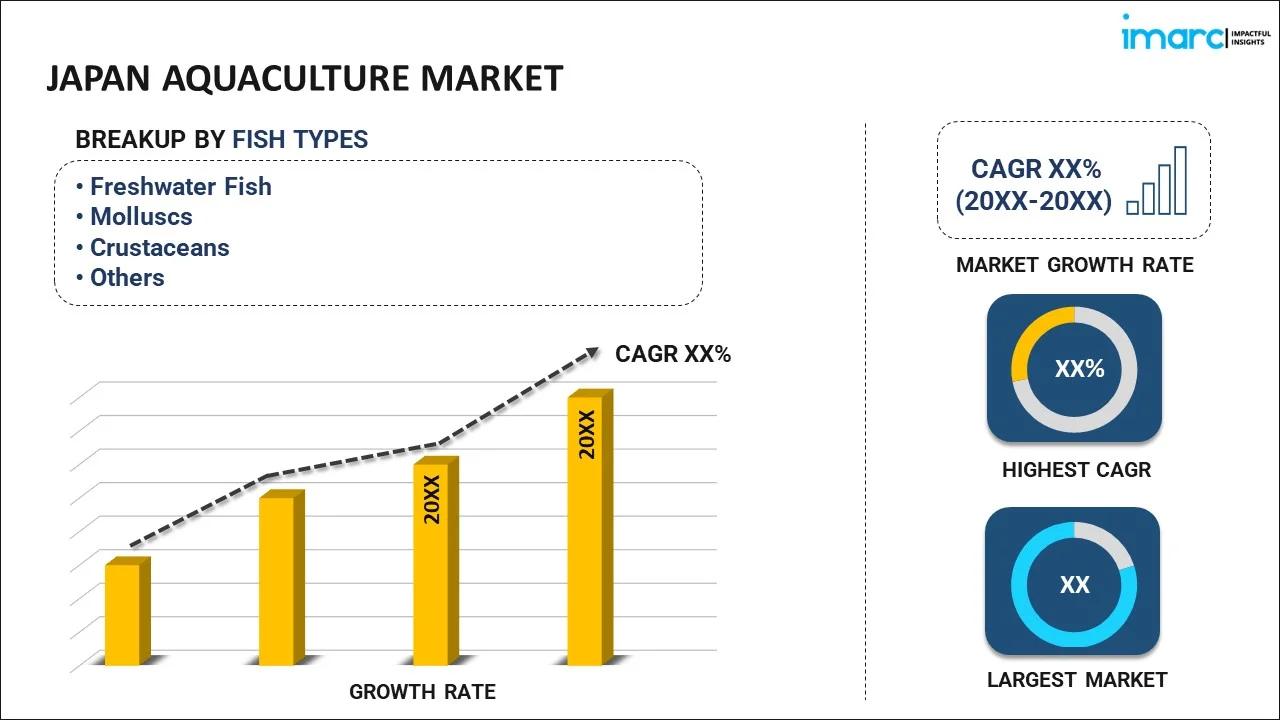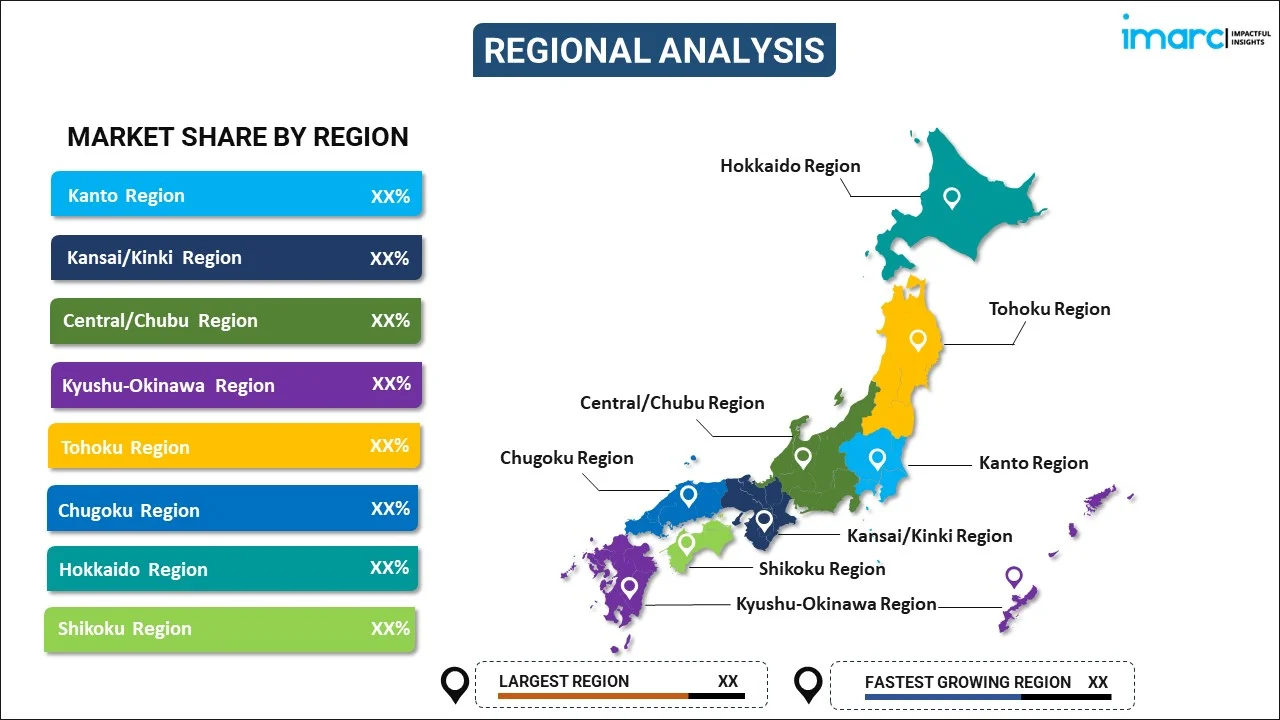
Japan Aquaculture Market Report by Fish Type (Freshwater Fish, Molluscs, Crustaceans, and Others), Environment (Fresh Water, Marine Water, Brackish Water), Distribution Channel (Traditional Retail, Supermarkets and Hypermarkets, Specialized Retailers, Online Stores, and Others), and Region 2025-2033
Market Overview:
Japan aquaculture market size reached 972.5 Thousand Tons in 2024. Looking forward, IMARC Group expects the market to reach 1,280.1 Thousand Tons by 2033, exhibiting a growth rate (CAGR) of 2.8% during 2025-2033. The increasing advancements in areas like biotechnology and genetics that can lead to the development of improved aquaculture species with desirable traits, such as disease resistance or faster growth, are driving the market.
|
Report Attribute
|
Key Statistics
|
|---|---|
|
Base Year
|
2024
|
|
Forecast Years
|
2025-2033
|
|
Historical Years
|
2019-2024
|
|
Market Size in 2024
|
972.5 Thousand Tons |
|
Market Forecast in 2033
|
1,280.1 Thousand Tons |
| Market Growth Rate 2025-2033 | 2.8% |
Aquaculture is a method of cultivating aquatic organisms, such as fish, shellfish, and plants, under controlled conditions. It involves the artificial breeding, rearing, and harvesting of aquatic species for food, commercial, and conservation purposes. Unlike traditional fishing, aquaculture provides a more sustainable and predictable source of seafood, helping to alleviate pressure on wild fish populations and protect fragile ecosystems. In aquaculture, various systems are employed, including ponds, tanks, cages, and raceways, to create optimal environments for the growth and development of aquatic species. Water quality, temperature, and nutrition are carefully managed to ensure healthy and efficient production. Aquaculture plays a crucial role in meeting the growing regional demand for seafood while also contributing to economic development in many regions. However, it faces challenges such as disease management, environmental impacts, and the responsible use of resources. Sustainable practices and advancements in technology are essential to address these issues and ensure the long-term viability of aquaculture as a critical component of the food supply.
Japan Aquaculture Market Trends:
The aquaculture market in Japan is experiencing a surge in growth and popularity due to several key market drivers. Firstly, the increasing regional demand for seafood, driven by a growing population and shifting dietary preferences towards healthier protein sources, has propelled the aquaculture industry forward. This rising need has created a compelling incentive for farmers to expand their aquaculture operations. Furthermore, environmental concerns and overfishing of wild fish stocks have raised alarms about the sustainability of traditional fishing practices. As a result, aquaculture has emerged as a more sustainable alternative, leading to increased investments and government support. In addition to this, advancements in technology have played a crucial role in the expansion of the aquaculture market. Innovations in fish breeding, water quality management, and automation have made fish farming more efficient and cost-effective. These technological developments have not only boosted production but also reduced the environmental footprint of aquaculture operations. Lastly, consumer awareness and demand for responsibly sourced seafood, which have encouraged the adoption of eco-friendly practices within the aquaculture industry to supply certified and sustainable products, are expected to drive the market in Japan during the forecast period.
Japan Aquaculture Market Segmentation:
IMARC Group provides an analysis of the key trends in each segment of the market, along with forecasts at the country level for 2025-2033. Our report has categorized the market based on fish type, environment, and distribution channel.
Fish Type Insights:

- Freshwater Fish
- Molluscs
- Crustaceans
- Others
The report has provided a detailed breakup and analysis of the market based on the fish type. This includes freshwater fish, molluscs, crustaceans, and others.
Environment Insights:
- Fresh Water
- Marine Water
- Brackish Water
A detailed breakup and analysis of the market based on the environment have also been provided in the report. This includes fresh water, marine water, and brackish water.
Distribution Channel Insights:
- Traditional Retail
- Supermarkets and Hypermarkets
- Specialized Retailers
- Online Stores
- Others
The report has provided a detailed breakup and analysis of the market based on the distribution channel. This includes traditional retail, supermarkets and hypermarkets, specialized retailers, online stores, and others.
Regional Insights:

- Kanto Region
- Kansai/Kinki Region
- Central/ Chubu Region
- Kyushu-Okinawa Region
- Tohoku Region
- Chugoku Region
- Hokkaido Region
- Shikoku Region
The report has also provided a comprehensive analysis of all the major regional markets, which include Kanto Region, Kansai/Kinki Region, Central/ Chubu Region, Kyushu-Okinawa Region, Tohoku Region, Chugoku Region, Hokkaido Region, and Shikoku Region.
Competitive Landscape:
The market research report has also provided a comprehensive analysis of the competitive landscape in the market. Competitive analysis such as market structure, key player positioning, top winning strategies, competitive dashboard, and company evaluation quadrant has been covered in the report. Also, detailed profiles of all major companies have been provided.
Japan Aquaculture Market Report Coverage:
| Report Features | Details |
|---|---|
| Base Year of the Analysis | 2024 |
| Historical Period | 2019-2024 |
| Forecast Period | 2025-2033 |
| Units | Thousand Tons |
| Scope of the Report | Exploration of Historical and Forecast Trends, Industry Catalysts and Challenges, Segment-Wise Historical and Predictive Market Assessment:
|
| Fish Types Covered | Freshwater Fish, Molluscs, Crustaceans, Others |
| Environments Covered | Fresh Water, Marine Water, Brackish Water |
| Distribution Channels Covered | Traditional Retail, Supermarkets and Hypermarkets, Specialized Retailers, Online Stores, Others |
| Regions Covered | Kanto Region, Kansai/Kinki Region, Central/ Chubu Region, Kyushu-Okinawa Region, Tohoku Region, Chugoku Region, Hokkaido Region, Shikoku Region |
| Customization Scope | 10% Free Customization |
| Post-Sale Analyst Support | 10-12 Weeks |
| Delivery Format | PDF and Excel through Email (We can also provide the editable version of the report in PPT/Word format on special request) |
Key Questions Answered in This Report:
- How has the Japan aquaculture market performed so far and how will it perform in the coming years?
- What has been the impact of COVID-19 on the Japan aquaculture market?
- What is the breakup of the Japan aquaculture market on the basis of fish type?
- What is the breakup of the Japan aquaculture market on the basis of environment?
- What is the breakup of the Japan aquaculture market on the basis of distribution channel?
- What are the various stages in the value chain of the Japan aquaculture market?
- What are the key driving factors and challenges in the Japan aquaculture?
- What is the structure of the Japan aquaculture market and who are the key players?
- What is the degree of competition in the Japan aquaculture market?
Key Benefits for Stakeholders:
- IMARC’s industry report offers a comprehensive quantitative analysis of various market segments, historical and current market trends, market forecasts, and dynamics of the Japan aquaculture market from 2019-2033.
- The research report provides the latest information on the market drivers, challenges, and opportunities in the Japan aquaculture market.
- Porter's five forces analysis assist stakeholders in assessing the impact of new entrants, competitive rivalry, supplier power, buyer power, and the threat of substitution. It helps stakeholders to analyze the level of competition within the Japan aquaculture industry and its attractiveness.
- Competitive landscape allows stakeholders to understand their competitive environment and provides an insight into the current positions of key players in the market.
Need more help?
- Speak to our experienced analysts for insights on the current market scenarios.
- Include additional segments and countries to customize the report as per your requirement.
- Gain an unparalleled competitive advantage in your domain by understanding how to utilize the report and positively impacting your operations and revenue.
- For further assistance, please connect with our analysts.
 Inquire Before Buying
Inquire Before Buying
 Speak to an Analyst
Speak to an Analyst
 Request Brochure
Request Brochure
 Request Customization
Request Customization




.webp)




.webp)












